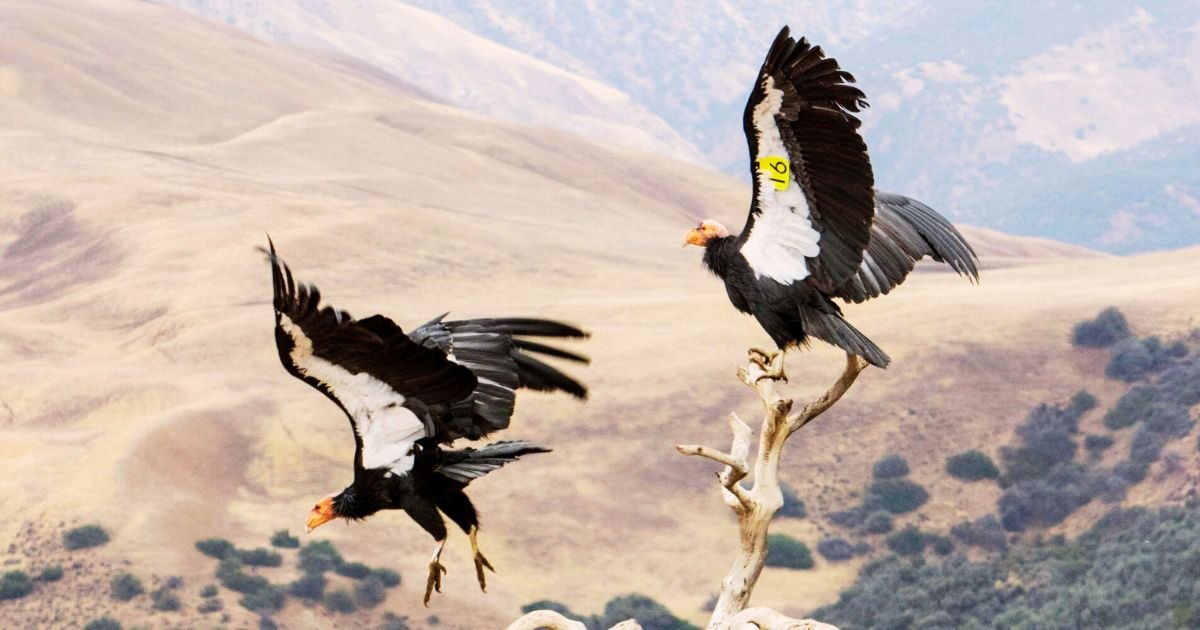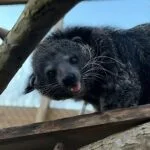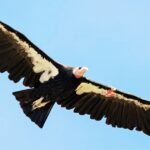Introduction
The California condor (Gymnogyps californianus) is a remarkable bird that holds the title of being the most giant flying bird in North America. With its wingspan stretching nearly 10 feet from tip to tip, this magnificent vulture glides on air currents, soaring as high as a dizzying 15,000 feet when in flight. In this comprehensive article, we’ll explore the fascinating world of the California condor, covering its history, characteristics, conservation efforts, and more.
Read More: National Birds Day 2024
Taxonomy and Evolutionary History
- The California condor is the only surviving member of the genus Gymnogyps, although four extinct members of the genus are also known.
- Its plumage is black with patches of white on the underside of the wings, and its head is largely bald, with skin colour ranging from gray on young birds to yellow and bright orange on breeding adults.
- With a wingspan of 3.0 meters (9.8 feet), it boasts the widest wingspan of any North American bird, and its weight of up to 12 kilograms (26 pounds) nearly equals that of the trumpeter swan, the heaviest among native North American bird species.
Ecology and Behavior
- The California condor is a scavenger, primarily feeding on large amounts of carrion.
- It is one of the world’s longest-living birds, with a lifespan of up to 60 years.
- Historically, condors ranged from California to Florida and Western Canada to Northern Mexico.
Decline and Conservation Efforts
- In the 20th century, condor numbers dramatically declined due to factors such as agricultural chemicals (DDT), poaching, lead poisoning, and habitat destruction.
- A conservation plan implemented by the United States government led to the capture of all remaining wild condors by 1987, leaving a total population of only 27 individuals.
- These surviving birds were bred in captivity at the San Diego Wild Animal Park and the Los Angeles Zoo.
- Beginning in 1991, condors were reintroduced into the wild, and their population has gradually grown.
- As of December 31, 2023, the total world population of California condors stands at.

Current Status and Challenges
Despite these conservation efforts, the California condor remains one of the world’s rarest bird species. Its survival depends on continued monitoring, habitat protection, and public awareness. Let us celebrate the triumphs achieved so far and continue working towards ensuring the majestic condor’s place in our natural heritage.
Soaring high above the rugged landscapes of western North America, the California condor cuts an iconic figure with its massive wingspan and distinctive bald head. This magnificent bird, once teetering on the brink of extinction, has undergone a remarkable revival, serving as a testament to the power of conservation efforts and the resilience of nature itself.
The Road to Recovery
In the 1980s, the California condor population had dwindled to a mere 22 individuals, the result of habitat loss, lead poisoning, and human persecution. Faced with the imminent extinction of this iconic species, conservationists took a daring step: they captured the remaining wild condors and initiated an intensive captive breeding program.
For over two decades, dedicated teams of biologists, zoos, and wildlife agencies worked tirelessly to boost the condor’s numbers through carefully managed breeding efforts. In 1992, the first captive-bred condors were released into the wild, marking a significant milestone in the species’ journey back from the brink.
Today, thanks to these tireless efforts, the California condor population has rebounded to over 500 individuals, with birds soaring freely across parts of California, Arizona, Utah, and Mexico.
Biological Marvels
The California condor is a true marvel of the avian world. It boasts several remarkable adaptations that have allowed it to thrive as a scavenger in rugged western landscapes.
Wingspan and Flight: With a wingspan that can exceed 9 feet (2.7 meters), the California condor is one of the most giant flying birds in North America. Its broad wings and efficient soaring abilities enable it to traverse vast distances with minimal effort, conserving energy as it searches for food.
Keen Eyesight and Sense of Smell: Condors possess exceptional eyesight and can spot carrion from great distances. Additionally, they have a well-developed sense of smell, which aids in locating food sources that might be obscured from view.
Digestive System: The condor’s digestive system is specially adapted to process tough, decaying matter. Its acidic stomach and powerful enzymes allow it to break down bones, hooves, and other rigid materials that would be indigestible for most other animals.
Longevity and Reproduction: California condors are long-lived birds, with some individuals reaching ages of 60 years or more in the wild. They have a slow reproductive rate, typically laying a single egg every other year, which underscores the importance of conservation efforts in ensuring the species’ long-term survival.
Ecological Importance
Beyond their impressive physical attributes, California condors play a crucial role in maintaining the health of the ecosystems they inhabit.
Scavengers and Recyclers: As obligate scavengers, condors act as nature’s cleanup crew, consuming carrion and helping to recycle nutrients back into the environment. Removing decomposing carcasses also helps to limit the spread of diseases and reduce potential risks to other wildlife and livestock.
Indicator Species: Healthy condor populations are often seen as an indicator of a well-functioning ecosystem. Their sensitivity to environmental changes and contaminants, such as lead poisoning from spent ammunition, makes them a valuable barometer for assessing the overall health of their habitats.
Cultural Significance California Condor
For many indigenous communities in the western United States and Mexico, the California condor holds deep cultural and spiritual significance.
Sacred Symbols: In various Native American traditions, the condor is revered as a powerful symbol of strength, longevity, and spiritual connection to the natural world. Its soaring flight and imposing presence have earned it a place of reverence in numerous creation stories and ceremonies.
Conservation Efforts and Challenges
While the recovery of the California condor is a remarkable conservation success story, ongoing efforts are necessary to ensure the species’ long-term survival and address the challenges it continues to face.
Lead Poisoning: One of the most significant threats to condors is lead poisoning, which occurs when the birds ingest lead fragments from the carcasses of animals shot with lead-based ammunition. Conservation organizations, in collaboration with hunting groups and government agencies, have been working to promote the use of non-lead alternatives and educate hunters about the importance of removing lead fragments from gut piles and carcasses.
Habitat Loss and Fragmentation: As human development encroaches on the condor’s natural habitats, preserving and connecting suitable areas for nesting, roosting, and foraging becomes increasingly essential. Efforts are underway to establish protected areas and create wildlife corridors to facilitate the movement and expansion of condor populations.
Human-Wildlife Conflicts: Occasional conflicts can arise when condors interact with human activities, such as feeding on livestock carcasses or nesting in areas near human settlements. Ongoing education and outreach programs aim to foster coexistence and minimize conflicts between condors and local communities.

Conclusion
The California condor’s remarkable journey from the brink of extinction to its current status as a conservation success story is a testament to the power of dedication, perseverance, and collective action. While challenges remain, the continued efforts of conservationists, researchers, and local communities offer hope for the long-term survival and flourishing of this iconic species.
As we marvel at the sight of these majestic birds soaring overhead, let us be inspired by their resilience and reminded of our responsibility to protect and preserve the natural wonders that share our world.
Read More: California Condor
Frequently Asked Questions (FAQ)
Q: Why are California condors endangered?
A: Factors include lead poisoning from ingesting lead ammunition in carcasses, habitat loss, and low reproductive rates.
Q: Where can I see California condors in the wild?
A: You can find them in California, Utah, Arizona, and Baja California.
Q: How can I help protect California condors?
A: Support conservation organizations, raise awareness, and advocate for responsible hunting practices.
Q: How many California condors are there in the wild today?
A: As of May 2024, approximately 350 California condors are living in the wild, with additional individuals in captive breeding programs.
Q: What is the primary threat to California condors?
A: Lead poisoning from ingesting lead fragments from the carcasses of animals shot with lead-based ammunition is a significant threat to condors.
Q: How long do California condors live?
A: California condors have a remarkable lifespan, with some individuals reaching ages of 60 years or more in the wild.
Q: Where do California condors currently live?
A: California condors can be found in parts of California, Arizona, Utah, and Mexico, with the largest populations residing in California and Arizona.
Q: How can people help protect California condors?
A: Supporting conservation organizations, advocating for the use of non-lead ammunition, and promoting the preservation of suitable habitats are all essential ways to help protect California condors.










